

Www.tpack.org. School Without Walls Fosters A Free-Wheeling Theory Of Learning. Sweden loves its experimental education, but here’s a venture that’s far-fetched even by Swedish standards: It’s a school without walls.
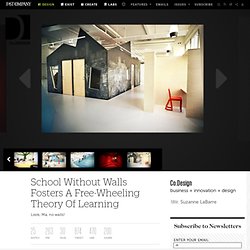
That’s right. Vittra Telefonplan, in Stockholm, was designed according to the principles of the Swedish Free School Organization Vittra, an educational consortium that doesn’t believe in classrooms or classes. So instead of endless rows of desks, it’s got neon-green “sitting islands” and whimsical picnic tables, where students and teachers gather. Instead of study hall, it has “Lunch Club,” a smattering of cafeteria-style tables on a checkerboard floor for working or eating (or both). And instead of an auditorium, it has a faceted blue amphitheatre that rises up in the middle of the school like a giant floating iceberg. Sounds great for the kids, but yikes, I feel sorry for their teachers.
Designer Rosan Bosch points out that Vittra Telefonplan isn’t totally wall-free. When planning the school, Bosch reached out to both teachers and students. What Americans Keep Ignoring About Finland's School Success - Anu Partanen - National. The Scandinavian country is an education superpower because it values equality more than excellence.
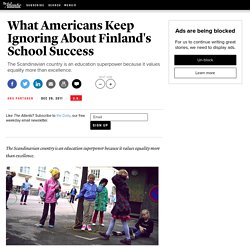
Sergey Ivanov/Flickr Everyone agrees the United States needs to improve its education system dramatically, but how? One of the hottest trends in education reform lately is looking at the stunning success of the West's reigning education superpower, Finland. Trouble is, when it comes to the lessons that Finnish schools have to offer, most of the discussion seems to be missing the point. Finnishing School. By Forget Santa Claus and saunas, the biggest export from Finland these days is its educational system.

During a two-day conference this week at Stanford University, Finnish educators discussed how they improved so dramatically and what the United States can learn from the Nordic country. Learning environments based on learning « Vittrabloggen. A Headmaster at one of our schools in Vittra called me one day and asked: ”- Ante, I have 400 pupils in my school but I have 600 chairs, could you explain that to me?”.
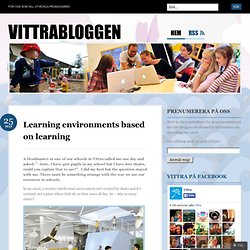
I did my best but the question stayed with me. There must be something strange with the way we use our resources in schools. In my mind, a creative intellectual environment isn’t created by chairs and it’s certainly not a place where kids sit on their asses all day. So – why so many chairs? Ask anyone to envision ”a school”. D.news blog. Event Stanford Student Info Session: Feb. 11th Have you been itching to find out more about what kinds of design thinking classes and projects will be offered by the d.school this spring and next fall?

Here’s your chance to find out! Tuesday Feb. 11th, from 12:00-1:00pm the d.school will host an information expo. Learn more about the classes we’ll be offering this spring (and eat for… More. Thinking beyond the box. At first glance it seems an unlikely location for a revolution in school design.
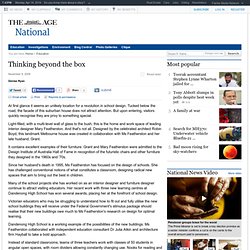
Tucked below the road, the facade of this suburban house does not attract attention. But upon entering, visitors quickly recognise they are privy to something special. Light-filled, with a multi-level wall of glass to the bush, this is the home and work space of leading interior designer Mary Featherston. And that's not all. Designed by the celebrated architect Robin Boyd, this landmark Melbourne house was created in collaboration with Ms Featherston and her late husband, Grant. It contains excellent examples of their furniture. Www.vit.vic.edu.au/SiteCollectionDocuments/PDF/1137_The-Effect-of-the-Physical-Learning-Environment-on-Teaching-and-Learning.pdf. Transforming Brisbane schools with Design Thinking. When we're working with schools on our Design Thinking School programme, one of the easiest ways to explain what we're looking for in the way a project is set, is whether the statement or questions being asked can be Googled easily: is this a Googleable or Not Googleable topic?

The Why Every topic, every bit of learning has content that can be Googled, and we don't want teachers wasting precious enquiry time lecturing that content. We want students, instead, to be using class time to collaborate and debate around the questions that are Not Googleable, the rich higher order thinking to which neither the textbook nor the teacher know the answers. And, where we do have "Googleable facts" for students to learn, the snap-decision shouldn't always be to 'teach' it. Auditory explanation alone (i.e. the teacher speaking) is only one tactic that is ineffective on its own in helping students internalise knowledge, as shown in experiments such as the Harvard "Private Universe" project, for example.
Www.uq.edu.au/nextgenerationlearningspace/NGLSCollRep08.pdf. Scholar.lib.vt.edu/theses/available/etd-08212007-163313/unrestricted/calvinbullock.pdf. Designing the 21st Century K-12 Classroom. Learning Spaces | Feature Designing the 21st Century K-12 Classroom Six design elements that shouldn't be left out of today's smart classroom By Bridget McCrea01/18/12 It's not enough to take a traditional K-12 classroom and fill it with technology.

SCIL Special Agents of Change. A View from the Middle Pedagogy and People over Places and Spaces. The impact of flexible learning spaces on student learning and achievement in a school-based setting; A snapshot of the discourse Studies about student academic achievement and building condition conclude that the quality of the physical environment significantly affects student achievement.

‘There is sufficient research to state without equivocation that the building in which students spends a good deal of their time learning does in fact influence how well they learn’ (VIT 2009 p1). Imagine Learning. As educators and leaders, we need to re-think every aspect of our professional practice to consider ‘could we be doing this better?’
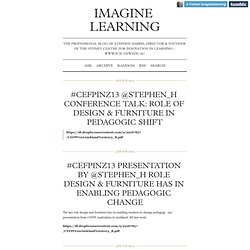
Here is a brain-dump of the 6 most powerful strategies that I have used or in which have participated. 1. Use a ‘hands-on’ approach that teaches team work I want the teachers for whom I am accountable to comprehensively embrace student centred, inquiry based learning. Stockholm’s School Without Classrooms. Www.jisc.ac.uk/media/documents/publications/learningspaces.pdf. Www.21csf.org/best-home/docuploads/pub/210_Lit-Review-LetterSize-Final.pdf. Uzspace.uzulu.ac.za/bitstream/handle/10530/735/Influence of Classroom Climate on Academic Achievement - J Chrisenduth.pdf?sequence=1.
Effects of the School Facility on Student Achievement - Visual (lighting and color) Influence of the School Facility on Student Achievement: Lighting: One of the most critical physical characteristics of the classroom is lighting (Phillips,1992). The importance of an appropriate visual environment for learning tasks deserves careful consideration. The visual environment affects a learner's ability to perceive visual stimuli and affects his/her mental attitude, and thus, performance.
Dunn (1985) insisted that the lightning of a school should be considered an active element of the total educational environment. Bowers and Burkett (1987) found that "improper maintenance of fixtures led to lower than average student performance such as misinterpretation of the written word, whether on a handout or at the chalkboard" (p.3). Classroom lighting plays a particularly critical role because of the direct relationship between good lighting and student's performance (Phillips, 1997).
Color: Www.oecd.org/dataoecd/26/7/37905387.pdf. Organise the learning space in the classroom to promote learning. It is possible to organise the learning space in the classroom so that students get the best opportunities to optimise their learning. Although classroom space is finite, even in the most basic 'square box' classroom there are opportunities to exploit the different ways students learn and, more importantly, the ways that students must learn, if their learning is to be the best it can be. Learning spaces - Technology Architecture and Furniture - Library learning community.
The Third Teacher. Powered by Keepeek Digital Asset Management. The End of Education Is the Dawn of Learning. If you want to know where Professor Stephen Heppell is, don't call his house or email his assistant -- check his Facebook page. Stephen has been known to fly around the world in ridiculously short amounts of time, stopping off at multiple locations to demonstrate how children of the third millennium are learning differently. What Schools Can Learn From Google, IDEO, and Pixar. A community about to build or rehab a school often creates checklists of best practices, looks for furniture that matches its mascot, and orders shiny new lockers to line its corridors.
These are all fine steps, but the process of planning and designing a new school requires both looking outward (to the future, to the community, to innovative corporate powerhouses) as well as inward (to the playfulness and creativity that are at the core of learning). In many ways, what makes the Googles of the world exceptional begins in the childhood classroom -- an embrace of creativity, play, and collaboration. It was just one year ago that 1,500 CEOs identified creativity as the number-one leadership competency in our complex global marketplace.
We can no longer afford to teach our kids or design their schoolhouses the way we used to if we’re to maintain a competitive edge. UOW - Innovative Learning Spaces - Resources. Open learning spaces. Learning Environments for the 21st Century. "Learning environments for the 21st century", chapter 2 in a new book on educational facilities released by the OECD gives you a few glimpses into the historical evolution of the classroom and looks at what education will need by way of learning space in the 21st century. Although it's about physical space, author Christian Kühn makes some points that can help digital learning designers answer questions like: how do you design the ideal learning environment, when we don't really know what that is yet?